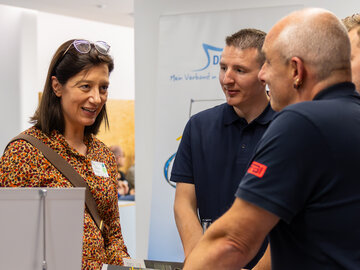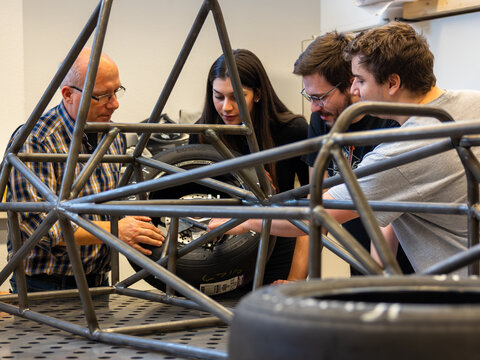
Always at the ready
Our self-image in transfer activities means that we take responsibility for the development of the region. At our university locations in Furtwangen, Schwenningen and Tuttlingen, and far beyond, we build reliable and trusting partnerships. HFU is equally committed to the transfer of ideas, knowledge and technology. To this end, it uses contributions from its core tasks of teaching, research and continuing education and uses its transfer activities to contribute to the outside world through openness, dialogue and networking.
In order for transfer to establish itself in the context of the 'Third Mission', transfer activities require recognition and appreciation from both HFU members and external transfer partners. This is supported by the development and agreement of quality-assuring, transparent and both quantitative and qualitative criteria for successful transfer.
- Transfer activities open up the core areas of teaching, research and continuing education to business and society.
- In transfer, HFU opens itself up to regional players in particular by both taking up needs and providing impetus.
- HFU and its practice partners, value the achievements of transfer in all its dimensions equally.
- Future-proof transfer activities use innovative methods that take into account different forms of knowledge and ways of understanding in order to achieve results.
- Start-ups catalyse transfer by putting ideas, knowledge and technology into practice in an agile manner and promoting the regional economy.
- The university creates framework conditions for free spaces in which transfer actions are possible, which favor their development and make them connectable for further topics and activities.
Strengthening the transfer
Transfer action is described as a separate performance dimension in the university strategy and taken into account in the formulation of objectives. In the implementation of the strategy process, specific, value-based criteria for successful transfer action are developed for each dimension.
Value
Transfer action is described as a separate performance dimension in the university strategy and taken into account in the formulation of objectives. In the implementation of the strategy process, specific, value-based criteria for successful transfer action are developed for each dimension.
Transfer activities at HFU are made visible both internally and externally through documentation and communication. The development of a competence atlas guarantees that suitable transfer partners can be brought together precisely and that the existing competencies in the field of transfer are visible both inside and outside the university.
With the development of dimension-specific incentive systems in transfer activities, transfer is recognised as a service equivalent to a department's own reputation. Internal workshops on transfer methods and topics with internal and external expertise contribute to competence building and the further development of transfer activities throughout the university.
Structural and infrastructural requirements
Transfer action requires a diverse structural anchoring that takes into account the needs of an entry point and also enables differentiated transfer dimensions and practices.
Institutions are created and interfaces between existing institutions (HFU Academy, IAF, IFC, Strategy and Communications Department, faculties) are defined, which develop a common understanding as transfer mediators. Through these support structures, contacts are established, maintained and networked, events are organised, activities are initiated, coordinated and accompanied in their implementation. The transfer mediators build up a shared pool of knowledge, for example in the form of a wiki on transfer (methods, process description, best practices).
New thematic innovation and transfer partnerships are developed and set up according to the 'CoHMed' model.
Transfer methods and processes
Development of a method of systematic scouting to identify the potential of research results with regard to their economic exploitation and social use.
Further development of methods for producing socially robust knowledge and for broadening the validation base of knowledge (dialogue methods, participatory methods, collaborative methods).
Further development of methods for co-designing research.
Transfer-oriented development and adaptation of processes (cooperation agreements, documentation scouting, confidentiality, data protection, licensing, event management, etc.) to enable agile transfer management.
The scientific-theoretical and scientific-political foundation of transfer activities is communicated visibly throughout the university.
Formats, instruments and practices of transfer action
Development, testing and application of transfer-oriented dialogical formats:
- open innovation to promote open cooperation in order to work on jointly set tasks
- consultative and public research to generate transfer-oriented research impulses
- start-up competitions to provide incentives for idea-, knowledge- and technology-based start-up projects
- collaborative transfer-oriented student projects in creative exchange with industry (e.g. student 'think tanks').
Use of new instruments:
- scouting to identify transfer-relevant activities or needs (research, start-ups, inventions)
- experimental collaboration (e.g. voting on research agendas using a regional currency)
Evaluation, reflection and further development of the transfer strategy
The university creates the necessary conditions for reflection and cooperation for the evaluation and continuous development of the transfer strategy in the sense of a learning system. The process for the systematic evaluation of transfer activities at HFU is implemented in the university's own quality assurance system FINQUAS. The respective needs and characteristics of the individual
of the individual transfer dimensions and practices are taken into account and, in particular, economic and trans-economic success criteria are defined.
